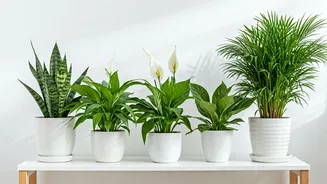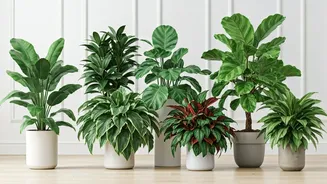Snake Plant's Oxygen Boost
The Snake Plant, also known as Sansevieria trifasciata, is celebrated for its ability to produce oxygen even during the night, making it ideal for bedrooms.
This unique characteristic helps improve indoor air quality and contributes to a more restful sleep. Additionally, the snake plant effectively removes several common indoor air pollutants, including benzene, formaldehyde, xylene, and toluene. Its low-maintenance nature makes it a perfect choice for both novice and experienced plant owners, thriving with minimal watering and light, thereby making it an efficient air purifier.
Spider Plant's Stress Relief
Spider Plants, or Chlorophytum comosum, are well-regarded for their air-purifying capabilities and their ease of care, making them perfect for beginners. They efficiently filter out pollutants like formaldehyde, xylene, and benzene from the air. Beyond their air-purifying prowess, Spider Plants also contribute to stress reduction. Their presence in the home can create a sense of calm. Moreover, the spider plant is simple to propagate, producing “spiderettes” or baby plants that can be easily replanted. These plants bring a blend of health and aesthetics to any living space.
Peace Lily's Quiet Power
The Peace Lily, Spathiphyllum, is a beautiful plant that is as efficient in purifying air as it is visually appealing. It’s an excellent choice for homes affected by various indoor pollutants, including formaldehyde, benzene, and trichloroethylene. This plant is known for its elegant white flowers. Peace Lilies also help to maintain moisture levels in the air, preventing dryness, which can worsen respiratory problems. The plant provides a healthy, comfortable, and visually pleasing environment. They thrive in moderate to low light conditions, making them ideal for various indoor settings.
Areca Palm's Humidifying Action
Areca Palms, or Dypsis lutescens, are more than just decorative plants. They serve as natural humidifiers, releasing moisture into the air, thereby combating dry indoor conditions. In addition to humidifying, Areca Palms filter common pollutants, including formaldehyde and xylene. The plant requires regular watering and bright, indirect light to flourish. Its broad leaves and lush appearance add to the aesthetics of a space while improving air quality. They are often chosen to create a healthier atmosphere in larger spaces. The plants provide a tropical feel while enhancing well-being.
English Ivy's Formaldehyde Defense
English Ivy, or Hedera helix, is particularly effective at removing formaldehyde, a common pollutant in homes. This plant can be grown indoors or outdoors. It effectively cleanses the air of numerous pollutants. English Ivy can be grown in hanging baskets or pots. It requires consistent care and pruning, making it slightly more demanding than the other plants. The plant is very efficient in purifying the air of allergens and pollutants, offering a healthier home environment. English Ivy's ability to purify the air makes it a valuable asset for anyone concerned about indoor air quality.
















